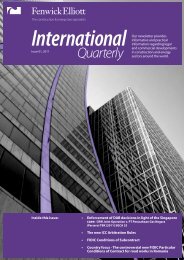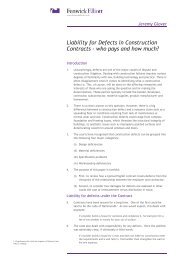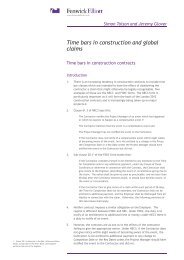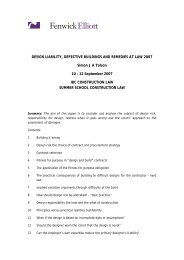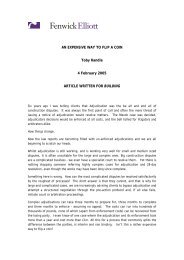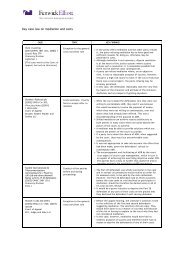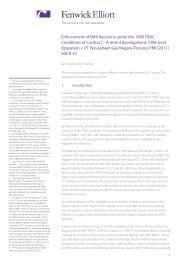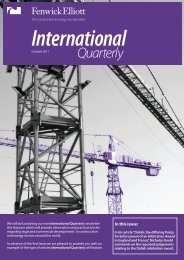CRW Joint Operation v. PT Perusahaan Gas Negara - Fenwick Elliott
CRW Joint Operation v. PT Perusahaan Gas Negara - Fenwick Elliott
CRW Joint Operation v. PT Perusahaan Gas Negara - Fenwick Elliott
You also want an ePaper? Increase the reach of your titles
YUMPU automatically turns print PDFs into web optimized ePapers that Google loves.
Issue 01 Winter 2011<br />
Our newsletter provides<br />
informative and practical<br />
information regarding legal<br />
and commercial developments<br />
in construction and energy<br />
sectors around the world.<br />
Inside this issue:<br />
• Enforcement of DAB decisions in light of the Singapore<br />
case: <strong>CRW</strong> <strong>Joint</strong> <strong>Operation</strong> v. <strong>PT</strong> <strong>Perusahaan</strong> <strong>Gas</strong> <strong>Negara</strong><br />
(Persero) TBK [2011] SGCA 33<br />
• The new ICC Arbitration Rules<br />
• FIDIC Conditions of Subcontract<br />
• Country focus - The controversial new FIDIC Particular<br />
Conditions of Contract for road works in Romania
Universal view:<br />
International dispute resolution & arbitration Issue 01 Winter 2011<br />
Enforcement of DAB decisions in<br />
light of the Singapore case:<br />
<strong>CRW</strong> <strong>Joint</strong> <strong>Operation</strong><br />
v. <strong>PT</strong> <strong>Perusahaan</strong> <strong>Gas</strong><br />
<strong>Negara</strong> (Persero) TBK<br />
[2011] SGCA 33<br />
By Frederic Gillion<br />
Partner, <strong>Fenwick</strong> <strong>Elliott</strong><br />
construction practitioners dealing with<br />
FIDIC Books.<br />
In <strong>PT</strong> <strong>Perusahaan</strong> <strong>Gas</strong> <strong>Negara</strong> (Persero) TBK<br />
(“PGN”) v. <strong>CRW</strong> <strong>Joint</strong> <strong>Operation</strong> (“<strong>CRW</strong>”) 1 ,<br />
the High Court of Singapore set aside<br />
an ICC arbitral award on the basis that<br />
the tribunal had exceeded its powers in<br />
making a final award ordering PGN to<br />
make immediate payment to <strong>CRW</strong> of the<br />
sum which the DAB had decided was due<br />
to <strong>CRW</strong>.<br />
The facts of the Singapore case<br />
In 2006, PGN, an Indonesian State owned<br />
company, entered into a contract with<br />
<strong>CRW</strong> for the construction by <strong>CRW</strong> of a<br />
pipeline and optical fibre cable from<br />
Grissik to Pagardewa in Indonesia. The<br />
contract incorporated the General<br />
Conditions of the FIDIC Conditions of<br />
Contract of the 1999 Red Book. The<br />
law governing the contract was that of<br />
Indonesia.<br />
Introduction<br />
A number of arbitral awards have<br />
recently come to light confirming the<br />
enforceability of non-final DAB decisions<br />
by ordering the losing party to pay<br />
immediately to the winning party the<br />
amounts ordered by the DAB even though<br />
a notice of dissatisfaction had been given<br />
in respect of those DAB decisions. Recent<br />
decisions from the High Court and the<br />
Court of Appeal of Singapore seem to<br />
go against the tide and are sending a<br />
confusing message to contractors and<br />
Following an appeal by <strong>CRW</strong>, the Court<br />
of Appeal confirmed the lower court’s<br />
decision to set aside that arbitral award<br />
in a judgment dated 13 July 2011 2 . In its<br />
decision, the Court of Appeal concluded<br />
that what the Arbitral Tribunal did in that<br />
arbitration – viz, summarily enforcing a<br />
binding but non-final decision by way of<br />
a final award without a hearing on the<br />
merits – was “unprecedented and more<br />
crucially, entirely unwarranted under the<br />
1999 FIDIC Conditions of Contract”.<br />
Although some of the findings of the<br />
Singapore court are questionable, they<br />
have the merits of reminding those<br />
involved with FIDIC Contracts that the<br />
enforcement of DAB decisions is not<br />
a simple matter and that a number of<br />
jurisdictional pitfalls exist which may<br />
prevent a winning party from obtaining in<br />
arbitration the amounts awarded by the<br />
DAB.<br />
A dispute arose between the Parties<br />
regarding certain variations in respect of<br />
which <strong>CRW</strong> sought additional payment.<br />
Following a referral of that dispute to the<br />
DAB, the DAB issued several decisions, all<br />
of which were accepted by PGN except<br />
for one dated 25 November 2008 ordering<br />
PGN to pay <strong>CRW</strong> a sum in excess of US$ 17<br />
million (“the DAB Decision”). The following<br />
day, on 26 November 2008, PGN gave<br />
notice of its dissatisfaction with the DAB<br />
Decision in accordance with Sub-Clause<br />
20.4 of the Conditions of Contract.<br />
PGN subsequently refused to comply<br />
with the DAB Decision. This led <strong>CRW</strong><br />
to file a request for arbitration with the<br />
ICC International Court of Arbitration in<br />
February 2009 (ICC Case No. 16122) in<br />
respect of PGN’s failure to comply with<br />
the DAB Decision. The dispute referred<br />
to arbitration, and a key point of this<br />
1 <strong>PT</strong> <strong>Perusahaan</strong> <strong>Gas</strong> <strong>Negara</strong> (Persero) TBK v. <strong>CRW</strong> <strong>Joint</strong> <strong>Operation</strong> [2010] SGHC 202.<br />
2 <strong>CRW</strong> <strong>Joint</strong> <strong>Operation</strong> v. <strong>PT</strong> <strong>Perusahaan</strong> <strong>Gas</strong> <strong>Negara</strong> (Persero) TBK [2011] SGCA 33.
Universal view:<br />
International dispute resolution & arbitration Issue 01 Winter 2011<br />
case was whether <strong>CRW</strong> was entitled to<br />
immediate payment by PGN of the sum<br />
awarded by the DAB in its Decision of 25<br />
November 2008 (“the Dispute”).<br />
<strong>CRW</strong>’s position was that, notwithstanding<br />
PGN’s notice of dissatisfaction, PGN still<br />
remained bound by the DAB Decision<br />
and was required to “promptly give effect”<br />
to that decision in accordance with Sub-<br />
Clause 20.4 of the Conditions of Contract.<br />
In its defence, PGN argued that the DAB<br />
Decision was not “final and binding” as<br />
it had served a notice of dissatisfaction<br />
and that a binding but not final decision<br />
could not be converted into a final arbitral<br />
award without first determining whether<br />
the DAB Decision was correct (or ought to<br />
be revised) on the merits by opening up<br />
and reviewing the DAB Decision. PGN in<br />
particular sought to argue that the powers<br />
of the Arbitral Tribunal set out in Sub-<br />
Clause 20.6 3 did not include the power<br />
to direct a party to make immediate<br />
payment of the sum awarded by the<br />
DAB without a review confirming the<br />
correctness of the DAB Decision.<br />
On 24 November 2009, a Final Award was<br />
rendered holding that the DAB Decision<br />
was binding and that PGN had an<br />
obligation to make immediate payment<br />
to <strong>CRW</strong> of the sum set out in the DAB<br />
Decision, namely US$ 17,298,834.57. The<br />
Arbitral Tribunal also dismissed in its award<br />
PGN’s interpretation of Sub-Clause 20.6<br />
and its argument that the Arbitral Tribunal<br />
should open up and review the DAB<br />
Decision, and noted that PGN still had the<br />
right to commence a separate arbitration<br />
to open up, review and revise the DAB<br />
Decision.<br />
<strong>CRW</strong> then proceeded to register the Final<br />
Award as a judgment in Singapore. In<br />
response, PGN applied to set aside the<br />
registration order and also sought an<br />
order from the High Court of Singapore<br />
to set aside the Final Award, on the basis<br />
inter alia that the Arbitral Tribunal had<br />
exceeded its jurisdiction by converting the<br />
DAB Decision into a Final Award without<br />
determining first whether the DAB was<br />
correct on the merits.<br />
By its decision dated 20 July 2010 (“the<br />
High Court Decision”), the High Court<br />
of Singapore found in PGN’s favour and<br />
set aside the Final Award for lack of<br />
jurisdiction of the Arbitral Tribunal.<br />
Dissatisfied with the High Court Decision,<br />
<strong>CRW</strong> filed an appeal, which was dismissed<br />
by the Court of Appeal of Singapore in its<br />
judgment dated 13 July 2011 (“the Court<br />
of Appeal Decision”).<br />
The High Court Decision<br />
In reaching its decision to set aside the<br />
Final Award, the High Court of Singapore<br />
examined the contractual framework<br />
set out in Clause 20 for the resolution<br />
of disputes between the Parties and<br />
in particular the requirement for a<br />
dispute to have gone through various<br />
steps, including a referral of the dispute<br />
to the DAB, before it may be referred<br />
to arbitration. It also considered the<br />
distinction between the proceedings<br />
envisaged by Sub-Clauses 20.6 and 20.7 of<br />
the Condition of Contract.<br />
The High Court held that the Arbitral<br />
Tribunal had acted outside its jurisdiction<br />
in two respects:<br />
(a)<br />
(b)<br />
The Dispute that <strong>CRW</strong><br />
referred to arbitration in ICC Case<br />
No. 16122 (namely PGN’s nonpayment<br />
of the sum set out in<br />
the DAB Decision as opposed<br />
to the underlying dispute) had<br />
not been first referred to the DAB<br />
and was therefore “plainly outside<br />
the scope of sub-cl 20.6 of the<br />
Conditions of Contract” 4 , and<br />
The arbitration proceedings<br />
commenced by <strong>CRW</strong> were<br />
made pursuant to Sub-Clause<br />
20.6 of the Conditions of<br />
Contract, which, according to<br />
the Singapore court, requires “a<br />
review of the correctness of the<br />
DAB Decision” 5 and must<br />
be distinguished from<br />
proceedings brought under<br />
Sub-Clause 20.7 which do not<br />
require the arbitral tribunal to<br />
consider the merits of the<br />
DAB decision. That distinction<br />
meant, according to the<br />
Singapore court, that the Arbitral<br />
Tribunal had acted outside<br />
its jurisdiction by making final a<br />
binding DAB decision without<br />
first hearing the merits of that<br />
DAB decision.<br />
3 Sub-Clause 20.6 of the Conditions of Contract: “The arbitrator(s) shall have full power to open up, review and revise any certificate, determination, instruction,<br />
opinion or valuation of the Engineer, and any decision of the DAB, relevant to the dispute.”<br />
4 Judgment, paragraph 31.<br />
5 Judgment, paragraph 37.
Universal view:<br />
International dispute resolution & arbitration Issue 01 Winter 2011<br />
What should <strong>CRW</strong> have done, according<br />
to the Singapore Court, to enforce its<br />
binding but not final DAB decision? The<br />
Singapore court dismissed the simple<br />
option of a referral to arbitration of the<br />
losing party’s failure to comply with the<br />
DAB decision. It held obiter that a winning<br />
party should do the following: (1) refer the<br />
underlying dispute covered by the DAB<br />
decision to arbitration and ask the Arbitral<br />
Tribunal to review and confirm the DAB<br />
decision; and (2) include a claim for an<br />
interim award in respect of the amount<br />
which the DAB ordered the losing party<br />
to pay.<br />
The Court of Appeal Decision<br />
Although the Court of Appeal ultimately<br />
confirmed the High Court Decision to set<br />
aside the Final Award, the basis on which<br />
it reached its decision is quite different.<br />
The basis for the Court of Appeal Decision<br />
dated 13 July 2011 essentially lies with<br />
the matters which the Arbitral Tribunal<br />
was appointed to decide as set out in<br />
the Terms of Reference signed by the<br />
parties. The Court of Appeal explains the<br />
following:<br />
“The TOR stated clearly that the<br />
Arbitration was commenced pursuant to<br />
sub-cl 20.6 of the 1999 FIDIC Conditions<br />
of Contract. Further, it is plain that under<br />
the TOR, the Arbitral Tribunal was, by the<br />
parties’ consent, conferred an unfettered<br />
discretion to reopen and review each<br />
and every finding by the Adjudicator.<br />
In other words, the Arbitral Tribunal was<br />
appointed to decide not only whether<br />
<strong>CRW</strong> was entitled to immediate<br />
payment of the sum of S$17,298,834.57<br />
...but also “any additional issues of fact<br />
or law which the Arbitral Tribunal, in its<br />
own discretion, [might] deem necessary<br />
to decide for the purpose of rendering<br />
its arbitral award”” 6 .<br />
With what the Court of Appeal describes<br />
as “this crucial backdrop in mind”, it went<br />
on to consider whether the Final Award<br />
was issued in accordance with Sub-Clause<br />
20.6. The Court of Appeal found that, by<br />
refusing to open up, review and revise<br />
the DAB Decision and proceeding instead<br />
to make a final award without reviewing<br />
the merits of that decision, the Arbitral<br />
Tribunal had ignored the clear language<br />
of Sub-Clause 20.6 to “finally [settle]” the<br />
dispute between the parties. The Court<br />
of Appeal considered that “What the<br />
Majority Members ought to have done,<br />
in accordance with the TOR [Terms of<br />
Reference] (and, in particular, sub-cl 20.6<br />
of the 1999 FIDIC Conditions of Contract),<br />
was to make an interim award in favour<br />
of <strong>CRW</strong> for the amount assessed by the<br />
Adjudicator (or such other appropriate<br />
amount) and then proceed to hear the<br />
parties’ substantive dispute afresh before<br />
making a final award.” 7<br />
The Court of Appeal considered that the<br />
Final Award was therefore not issued<br />
in accordance with Sub-Clause 20.6,<br />
which in turn raised the question of<br />
whether the Arbitral Tribunal exceeded<br />
its jurisdiction in making the Final Award<br />
(Article 34(2)(a)(iii) of Model Law) and<br />
whether it breached the rules of natural<br />
justice (Section 24(b) of the Singapore<br />
International Arbitration Act). These were<br />
the two grounds relied upon by PGN<br />
for setting aside the Final Award and<br />
accepted by the Court of Appeal in this<br />
appeal 8 .<br />
Implications of the Singapore case<br />
The implications of these decisions<br />
from the High Court and the Court of<br />
Singapore are difficult to predict. One<br />
thing is certain, the conclusion of the High<br />
Court is already being relied upon in other<br />
arbitration proceedings in support of<br />
defences to claims for immediate payment<br />
of amounts awarded by DABs as well as in<br />
enforcement proceedings. For this reason,<br />
the decisions of the High Court and the<br />
Court of Appeal of Singapore merit careful<br />
examination.<br />
A thorough analysis of the High Court<br />
Decision shows that the Singapore<br />
Court seems to have been misguided<br />
in its interpretation of Sub-Clauses 20.6<br />
and 20.7. There is nothing in the FIDIC<br />
Conditions of Contract which would<br />
prevent a winning party from referring<br />
to arbitration simply the issue of the<br />
other party’s failure to comply with a DAB<br />
decision, as a second dispute, without<br />
having to refer also the underlying<br />
6 Court of Appeal Decision, paragraph 43<br />
7 Court of Appeal Decision, paragraph 79.<br />
8 PGN did not dispute the decision of the High Court to reject its submissions on Article 34(2)(a)(iv) of the Model Law, namely that “the arbitral procedure was<br />
not in accordance with the agreement of the parties, which required the merits of the underlying dispute and/or the question of whether the DAB Decision<br />
was made in accordance with the Contract to be determined prior to making that decision a final award” (High Court Decision, paragraph 9).
Universal view:<br />
International dispute resolution & arbitration Issue 01 Winter 2011<br />
dispute. It should therefore be possible<br />
for a winning party to commence a<br />
relatively straightforward arbitration<br />
simply based on the other party’s breach<br />
of Sub-Clause 20.4. Only one condition<br />
should not be overlooked by the winning<br />
party before doing so: that second dispute<br />
must have been first referred to the DAB<br />
and an adequate and timely notice of<br />
dissatisfaction must have been served in<br />
respect of that second DAB decision.<br />
In that respect, the High Court of<br />
Singapore was correct when it concluded<br />
that since the Dispute which <strong>CRW</strong> referred<br />
to arbitration (namely PGN’s non-payment<br />
of the sum set out in the DAB Decision)<br />
had not been first referred to the DAB,<br />
it was plainly outside the jurisdiction of<br />
the Arbitral Tribunal. This was the right<br />
conclusion given the current wording of<br />
Sub-Clause 20.7. Sub-Clause 20.7 makes<br />
clear that the only situation where a party<br />
may refer directly to arbitration the other<br />
party’s failure to give effect to a DAB<br />
decision without having to comply first<br />
with the requirements of Sub-Clause 20.4<br />
[Obtaining Dispute Adjudication Board’s<br />
Decision] and Sub-Clause 20.5 [Amicable<br />
Settlement] is in the event that no party<br />
has expressed dissatisfaction with the DAB<br />
decision and that DAB decision becomes<br />
as a result final and binding. In ICC Case<br />
No. 16122, a notice of dissatisfaction had<br />
been given by PGN, making the DAB<br />
Decision binding but not final. Sub-Clause<br />
20.7 was therefore not applicable.<br />
It will be interesting to see how the<br />
problem of the enforcement of DAB<br />
decisions will be addressed in the second<br />
edition of the 1999 FIDIC Books which<br />
are expected to be published next year.<br />
One approach which the FIDIC Contracts<br />
Committee might adopt will be to amend<br />
Clause 20 along the lines of the FIDIC<br />
Gold Book 2008 by adding in Sub-Clause<br />
20.6 that the DAB decision is binding<br />
and the parties have to comply with it<br />
“notwithstanding that a Party gives a<br />
Notice of Dissatisfaction with such a<br />
decision” and by providing in Sub-Clause<br />
20.7 9 that in the event that a party fails<br />
to comply with a decision of the DAB,<br />
whether binding or final and binding,<br />
then the other party may refer the failure<br />
itself to arbitration without having to refer<br />
first that matter to the DAB and then to<br />
wait for the amicable settlement period to<br />
expire.<br />
These amendments would bring<br />
more certainty to what is currently an<br />
ambiguous section of the 1999 suite<br />
of FIDIC contracts and would no<br />
doubt give parties more faith in the<br />
DAB process and its outcome.<br />
A full version of this article was<br />
published in the September<br />
2011 issue of the International<br />
Construction Law Review.<br />
Frederic Gillion, Partner<br />
<strong>Fenwick</strong> <strong>Elliott</strong><br />
+44 (0)207 421 1986<br />
fgillion@fenwickelliott.com<br />
9 Interestingly, the Court of Appeal makes no reference to this in its decision.
Commentary:<br />
International dispute resolution & arbitration Issue 01 Winter 2011<br />
The new ICC Arbitration Rules<br />
By Richard Smellie<br />
Partner, <strong>Fenwick</strong> <strong>Elliott</strong><br />
Introduction<br />
The ICC International Court of Arbitration<br />
has revised its Arbitration Rules. The<br />
present Rules where published in 1998.<br />
The new Rules come into effect from<br />
1 January 2012. Unless an existing ICC<br />
arbitration clause calls for the application<br />
of the ICC rules as at the date of the<br />
contract, the new rules will apply to any<br />
arbitration commenced after 1 January<br />
2012.<br />
The ICC International Court of Arbitration<br />
is now arguably the dominant source<br />
of administered arbitration, and a core<br />
business for the International Chamber of<br />
Commerce. The new Rules are an update,<br />
and in a number of respects set out the<br />
practice developed by the Court over the<br />
past 10 years, providing transparency and<br />
greater certainty, particularly in relation to<br />
multi party arbitration, consolidation and<br />
jurisdictional challenge.<br />
A number of the changes are an update:<br />
the Chairman of the Tribunal is now the<br />
President, references to ‘telex’ have been<br />
replaced with e mail, and the rules are<br />
said to cover simply “disputes” rather<br />
than “business disputes” so that there is<br />
no suggestion that disputes involving<br />
States are somehow excluded. The early<br />
quantification of claims in the Request<br />
for Arbitration is now encouraged<br />
by Article 4(3)(d), and Article 11 now<br />
requires arbitrators to be impartial, and to<br />
confirm their impartiality (it having been<br />
previously assumed that ‘impartiality’<br />
was covered by the confirmation of<br />
‘independence’). Further by Article 13,<br />
where the Court does not accept the<br />
proposal of a National Committee, or one<br />
party is a State, or the President of the<br />
Court considers it necessary, then the<br />
Court now has the power to appoint as<br />
arbitrator any person it considers suitable.<br />
The much debated topic of confidentiality<br />
has also been addressed. Contrary<br />
to the understanding of many users<br />
of international arbitration, it is not<br />
automatically confidential. The new<br />
ICC Rules do not change that for ICC<br />
administered arbitration, but expressly<br />
provide at Article 22 (3) that the Tribunal<br />
may, upon the request of the parties, make<br />
orders concerning the confidentiality of<br />
the arbitration.<br />
The most significant changes are in three<br />
areas: case management (which the rules<br />
require and actively encourage), interim<br />
and conservatory measures (where<br />
the ICC has introduced an Emergency<br />
Arbitrator procedure) and multi party<br />
disputes (which are now provided for,<br />
the practice of the Court having been<br />
enshrined in the Rules).<br />
Case management<br />
The 1998 Rules called for the arbitration<br />
to be complete within 6months, and<br />
the practice has been that the Court will<br />
approve extensions to that time frame as<br />
needed (and extensions have usually been<br />
needed). Under the new Rules, Article 22<br />
now includes an express obligation on the<br />
parties (as well as the Tribunal) to make<br />
every effort to conduct the arbitration ‘in<br />
an expeditious and cost effective manner’,<br />
(Article 22(1))and at 22(2) obliges the<br />
Tribunal to adopt measures to ensure<br />
effective case management (provided any<br />
such measures are not contrary to any<br />
agreement of the parties).<br />
Article 24, and Appendix IV, are entirely<br />
new. Article 24 requires the Tribunal to<br />
call a case management conference, at<br />
the outset of the proceedings, when<br />
the Terms of Reference are drawn up<br />
(this being a particular feature of ICC<br />
arbitration: it is the first task of the Tribunal<br />
following receipt of the file from the<br />
Court), or immediately thereafter. The<br />
objective – and indeed obligation – is to<br />
consult with the parties on procedural<br />
measures that might be adopted pursuant<br />
to Article 22(2) ‘to ensure effective case<br />
management’.<br />
In order to further encourage case<br />
management, Article 24 calls on the<br />
Tribunal to hold subsequent case<br />
management conferences ‘to ensure<br />
continued effective case management’,<br />
and at 24(4) the Tribunal is empowered to
Commentary:<br />
International dispute resolution & arbitration Issue 01 Winter 2011<br />
request the attendance of a party<br />
representative at a case management<br />
conference, the intention being to secure<br />
the parties ‘buy in’ to effective case<br />
management procedures.<br />
Appendix IV provides examples of case<br />
management techniques that might be<br />
adopted. None of the proposals in this<br />
appendix are in themselves radical, but<br />
the appendix provides a useful list of<br />
possible case management techniques.<br />
The list includes various proposals aimed<br />
at limiting disclosure, and looking for<br />
areas where the parties or their experts<br />
might agree, limiting the length of<br />
written submissions and evidence, and<br />
looking at bifurcation, the use of IT, and<br />
giving consideration to whether there<br />
are issues that might be decided on a<br />
documents only basis. It also includes<br />
encouragement to the parties to consider<br />
settlement.<br />
The case management provisions<br />
conclude at Article 27, where a new<br />
obligation is placed upon the Tribunal: at<br />
the conclusion of the proceedings, when<br />
the Tribunal declares the proceedings<br />
closed, the Tribunal must now also inform<br />
the Secretariat and the parties of the date<br />
by which the Tribunal expects to submit<br />
its draft award to the Court for approval.<br />
Emergency Arbitrator<br />
Whilst the 1998 Rules made provision<br />
for the issue of interim or conservatory<br />
measures by the Tribunal once<br />
established, they did not provide a<br />
mechanism for urgent application<br />
pending the Tribunal being constituted.<br />
Consequently parties with an ICC<br />
arbitration clause would have to look<br />
to local courts for any urgent interim or<br />
conservatory measures, or wait for the<br />
Tribunal to be constituted – a process that<br />
could take several months.<br />
The new Rules however now provide,<br />
at Article 29 and Appendix 5, for the<br />
appointment of an Emergency Arbitrator<br />
to make orders for urgent interim or<br />
conservatory measures, a procedure that<br />
has been included in a number of other<br />
administered arbitral rules (the SIAC and<br />
Stockholm rules being examples).<br />
Appointment of the Emergency Arbitrator<br />
is made upon request to the Secretariat<br />
(Article 29(1)). The request must be made<br />
before the transmission of the file to the<br />
Tribunal if a Request for Arbitration has<br />
already been lodged. The appointment<br />
is made by the President of the ICC Court,<br />
who also decides whether the emergency<br />
provisions apply. Further the fee ($40,000)<br />
must be paid before the application will<br />
be notified to the Parties under Appendix<br />
IV Article 2, and the emergency procedure<br />
commenced.<br />
The Emergency Arbitrator must act fairy<br />
and impartially, and allow each party<br />
reasonable opportunity to present its case<br />
(Appendix IV, Article 5 (2)). By Appendix IV,<br />
Article 6(4) the Emergency Arbitrator must<br />
send his order to the Parties within 15<br />
days from the date the file is transmitted<br />
to him, and the date of transmission<br />
is expected to be on the emergency<br />
arbitrators appointment, which should<br />
be within two days of the request for the<br />
appointment having been made (2(1)).<br />
If a Request for Arbitration has not<br />
already been made by the party<br />
seeking the urgent interim relief, that<br />
Request must be made within 10 days<br />
of making application, failing which the<br />
President must terminate the emergency<br />
proceedings (Appendix IV, Article 1 (6)).<br />
It is important to note that by Article 29(2),<br />
the emergency arbitrator’s decision takes<br />
the form of an order, and not an award,<br />
and by Article 29(3) does not bind the<br />
Tribunal ultimately established to resolve<br />
the dispute. It is not therefore in the<br />
nature of a final, binding decision of an<br />
arbitrator, with the result that it is unlikely<br />
to be enforceable as an arbitrator’s award.<br />
Its “teeth” however, are found in the power<br />
given at Article 29(4) to the Tribunal<br />
appointed to determine the dispute,<br />
to decide upon any claims relating to<br />
the emergency arbitrator proceedings.<br />
Noncompliance with an emergency<br />
arbitrator’s order could, therefore, result in<br />
a claim.<br />
It is also important to note that the Parties<br />
are expressly given the option to opt-out<br />
of these provisions. As arbitration is a<br />
process born of contract, parties could, by<br />
agreement, say that any particular parts of<br />
the Rules do not apply, but if that included<br />
rules which the ICC Court considers<br />
fundamental to ICC arbitration, then the<br />
ICC Court would decline to administer<br />
the arbitration. Whether the emergency<br />
arbitrator procedure might be regarded as<br />
fundamental is not known, but the Parties<br />
have been given the express right to opt<br />
out should they so choose.<br />
Further, by Article 29(6), these provisions<br />
will not apply to arbitration agreements<br />
entered onto before 1 January 2012,<br />
and by Article 29(7), it is not intended to<br />
prevent a party applying to local courts for<br />
interim or conservatory relief.
Commentary:<br />
International dispute resolution & arbitration Issue 01 Winter 2011<br />
Multi party disputes/multiple contracts<br />
For the first time, the ICC Rules now<br />
include provision for multi party disputes<br />
and multiple contract arbitrations. These<br />
are found at Articles 7, 8 and 9, with Article<br />
6 (Effect of the arbitration agreement) and<br />
Article 10 (Consolidation of Arbitrations)<br />
having been amended to take account of<br />
the new multi party provisions.<br />
It is important to note that these<br />
provisions do not answer whether a<br />
Party might be joined and/or whether<br />
all disputes referred might be heard in<br />
a single arbitration. Rather they set out<br />
a framework for the resolution of these<br />
issues. The framework reflects the present<br />
practice of the ICC Court.<br />
Article 6 now gives the Court the power<br />
to make a prima facie decision where a<br />
proposed Respondent raises an issue<br />
as to whether all of the claims made in<br />
an arbitration can be heard in a single<br />
arbitration. If the matter is referred to the<br />
Court by the Secretary General, to allow<br />
the arbitration to proceed the Court must<br />
be satisfied that, for multi Parties, there is<br />
prima facie arbitration agreement under<br />
the ICC rules that binds all of the Parties,<br />
and for multiple contracts, that there<br />
are prima facie compatible arbitration<br />
agreements and that all Parties have<br />
agreed that the claims can be determined<br />
together in a single arbitration.<br />
Any decision of the Court remains subject<br />
to the decision of the Tribunal. For the<br />
joinder of additional Parties (Article 7),<br />
the Request for Arbitration against the<br />
additional Party must be made before the<br />
confirmation or appointment of any of<br />
the arbitrators (unless the Parties agree<br />
otherwise), and the request must include<br />
information concerning the arbitration<br />
agreement relied upon, and, if there is<br />
more than one arbitration agreement, the<br />
arbitration agreement relied upon for each<br />
claim made.<br />
A Party so joined files an Answer, and<br />
may bring a cross claim against any Party<br />
in the arbitration. By Article 8 however,<br />
like the Request that joined this Party,<br />
where it makes a cross claim its Answer<br />
must include information concerning<br />
the arbitration agreement relied upon,<br />
and if there is more than one arbitration<br />
agreement, the arbitration agreement<br />
relied upon for each claim made.<br />
Through this procedure therefore, any<br />
Party that is joined is given opportunity<br />
to play a part in the constitution of the<br />
Tribunal, and to raise any jurisdictional<br />
objection from the outset. Further, and<br />
importantly, the Tribunal is provided with<br />
the basic information it will need where<br />
there is an issue as to jurisdiction.<br />
Article 9 supplements these provisions,<br />
by confirming that subject to the Court<br />
allowing the arbitration to proceed<br />
under Article 6, claims arising from more<br />
than one contract can be brought in a<br />
single arbitration. This does not however<br />
impinge on the Tribunal’s authority to<br />
determine any jurisdictional issue that<br />
might be raised.<br />
Finally, by Article 10, the Court is now<br />
empowered to consolidate arbitrations<br />
where claims are made under more<br />
than one arbitration agreement, and<br />
the disputes arise in connection with<br />
the same legal relationship, and where<br />
the Court finds that the arbitration<br />
agreements are compatible.<br />
Conclusion<br />
The new ICC Rules are to be welcomed.<br />
They bring the ICC Rules up to date,<br />
and into line with modern practice and<br />
expectations. There will inevitably be<br />
some uncertainty as to how some of the<br />
more complex provisions concerning<br />
emergency arbitrators and multi party<br />
disputes will work, but the new Rules<br />
have been carefully thought through and<br />
drafted, and appear fit for purpose.<br />
Richard Smellie, Partner<br />
<strong>Fenwick</strong> <strong>Elliott</strong><br />
+44(0)207 421 1986<br />
rsmellie@fenwickelliott.com
Universal view:<br />
International contractual issues around the globe Issue 01 Winter 2011<br />
FIDIC Conditions of Subcontract<br />
By Jeremy Glover<br />
Partner, <strong>Fenwick</strong> <strong>Elliott</strong><br />
Quietly, in fact so quietly you may<br />
not have noticed, FIDIC has recently<br />
published its Conditions of Subcontract<br />
for Construction for use with the 1999<br />
FIDIC Red Book 1 . The test edition came<br />
out in 2009 with the formal version<br />
being released in October 2011. There<br />
have only been very minor changes<br />
between the two. The subcontract<br />
formally replaces the FIDIC Conditions<br />
of Subcontract for Works of Civil<br />
Engineering Construction, 1st Edition<br />
1994.<br />
In short the subcontract is intended to<br />
operate in the usual back-to-back basis,<br />
and, unsurprisingly, the subcontract<br />
provides for a direct total pass down of<br />
risk, with the subcontractor assuming the<br />
duties and obligations of the contractor<br />
under the main contract.<br />
This includes, at sub-cl.4.1, a fitness<br />
for purpose obligation in respect of<br />
any design work, something which is<br />
not in the 1994 version. This principle<br />
also applies to payment and one thing<br />
that will be of particular note to those<br />
familiar with operating in the UK market<br />
is inclusion of pay-when-paid conditions<br />
at sub-cl.14.6. These pay-when-paid<br />
provisions, of course, conflict with the<br />
payment requirements of the Housing<br />
Grants Act. FIDIC has included guidance<br />
notes and particular sample conditions<br />
to assist parties working in the UK and<br />
other jurisdictions with similar legislation.<br />
This is part of the general recognition<br />
on the part of FIDIC that while most of<br />
the clauses will be generally applicable,<br />
there may be some clauses which must,<br />
of necessity be amended to take account<br />
of the circumstances and locality of the<br />
Subcontract Works.<br />
One of the sub-clauses which provided<br />
much comment under the test edition,<br />
and which has been retained here, are<br />
the programming obligations under<br />
sub-cl.8.3 and Annex F. Indeed, whilst the<br />
programming obligations of sub-cl.8.3 of<br />
the main contract are fairly extensive, they<br />
are much less detailed than the<br />
the programming obligations under<br />
the FIDIC Subcontract 2011. These<br />
requirements are considerably more<br />
detailed both than those to be found<br />
in the 1994 version. This is even though<br />
sub-cl.8.5 notes that the Subcontractor<br />
monthly progress reports need only be<br />
in the same detail and format as the<br />
Contractor Reports. Annex F of the FIDIC<br />
Subcontract 2011 alone lists some 17<br />
separate requirements, a-q. These include<br />
logically linking all activities, identifying<br />
the critical path and all float, as well as<br />
including sufficient flexibility to interface<br />
the Subcontractor’s activities with the<br />
Contractor. The Subcontract programme<br />
must be submitted to the Contractor<br />
within 14 days of receiving the Letter<br />
of Acceptance. Then the Contactor has<br />
14 days to either approve or reject the<br />
programme. If the Contractor fails to<br />
respond then the initial programme<br />
becomes the Subcontract programme<br />
by default. The programme must be<br />
updated within seven days of the<br />
occurrence of one of six-listed events<br />
including the Subcontractor changing<br />
his methods or sequencing, there being<br />
any delay which impacts on the critical<br />
path or the Subcontractor receiving from<br />
the Contractor an instruction, pursuant<br />
to sub-cl.8.4 to accelerate where the<br />
Subcontractor’s progress is too slow.<br />
Employers under the FIDIC Red Book 1999,<br />
may well, if they are not already, start<br />
requiring a similar level of detail from the<br />
Contractor.<br />
Subcontractor claims<br />
As always, FIDIC has given considerable<br />
attention to the dispute resolution<br />
provisions. The subcontract contains<br />
its own dispute resolution procedures<br />
but as you would expect, the claims<br />
procedure for Subcontractors set out<br />
in the FIDIC Subcontract 2011 follows<br />
the scheme of the FIDIC Red Book 1999.<br />
1<br />
It is also intended to be used in conjunction with the FIDIC Conditions of Contract for Construction, MDB Harmonised Edition or Pink Book. However if this is the case<br />
both parties must take care to ensure that the subcontract has been amended to mirror the differences between the Pink and Red Books.
Universal view:<br />
International contractual issues around the globe Issue 01 Winter 2011<br />
Indeed the Subcontract perfectly mirrors<br />
the Main Contract such that there is no<br />
condition precedent attached to the<br />
time in which a Contractor must bring a<br />
claim, but the equivalent requirements<br />
on a Subcontractor are expressed in this<br />
way, albeit that this is only done by crossreference<br />
and so the Subcontractor would<br />
only know this by referring to sub-cl.20.1<br />
of the FIDIC Red Book 1999. Therefore<br />
if the Subcontractor puts in his claim<br />
outside of the time limit, the right to bring<br />
the claim might be lost for good, however<br />
meritorious the claim might otherwise<br />
be. Any such notice must be given within<br />
21 days, in order to give the Contractor<br />
the chance to give timely notice to the<br />
Employer, if appropriate. The remaining<br />
timescales are similarly shortened, such<br />
that the detailed claim must be submitted<br />
within 35 and not 42 days.<br />
Then the Contractor is required to consult<br />
with the Subcontractor to try and reach<br />
agreement on the claim, failing which<br />
the Contractor must then, within 42 days<br />
after receipt of the detailed claim, go on to<br />
make a “fair determination” of the claim.<br />
Sub-clause 20.3 of the FIDIC Subcontract<br />
2011 notes that if by reason of any<br />
failure by the Subcontractor to follow<br />
the requirements set out in sub-cl.20.1<br />
and 2, the Contractor is prevented<br />
from recovering any sum other than in<br />
respect of a Subcontractor claim then<br />
the Contractor, provided it follows the<br />
appropriate claims process itself, shall<br />
be entitled to deduct that sum from the<br />
Subcontract Price.<br />
Subcontractor claims to the DAB<br />
The general scheme under the 1999 Red<br />
book is this:<br />
(i) A dispute is referred to the DAB;<br />
(ii) The DAB then has 84 days to reach its<br />
decision;<br />
(iii) A party then has 28 days to serve a<br />
Notice of Dissatisfaction otherwise<br />
that Decision becomes binding;<br />
(iv) There is then a 56-day period for<br />
amicable settlement; and if there is no<br />
settlement then<br />
(v) A reference can be made to<br />
Arbitration.<br />
The provisions of the FIDIC Subcontract<br />
2011 take steps to try and ensure that<br />
disputes arising out of the Subcontract<br />
can be dealt with, without prejudicing<br />
the rights of either the Contractor (and<br />
therefore possibly the Subcontractor too)<br />
under the main Contract.<br />
Sub-cl.20.4, provides that if the Contractor<br />
considers 2 that the dispute raised by the<br />
Subcontractor is a dispute which involves<br />
an issue related to a dispute between the<br />
Contractor and Employer under the main<br />
Contract then, the Parties shall (a) defer<br />
referral of the dispute to the Subcontract<br />
for 112 days and (b) if the dispute has<br />
not been previously referred under the<br />
main Contract, the Contractor must refer<br />
the new dispute within 28 days. This is a<br />
positive obligation on the Contractor. The<br />
Subcontractor is understandably obliged<br />
to give the Contractor in good time any<br />
assistance that may be required 3 during<br />
the hearing process.<br />
Under sub-cl. 20.4 of the FIDIC<br />
Subcontract 2011, the Subcontractor<br />
will not be bound by the DAB Decision<br />
under the main Contract, but this should<br />
be checked as the particular conditions<br />
give an alternative cl.20 to be used where<br />
the Subcontractor is to be bound by a<br />
determination. If no notice is given by the<br />
Contractor that the dispute is a Related<br />
Issue then either party is entitled to refer<br />
the dispute to the Subcontract DAB.<br />
This new Subcontract is a further step<br />
along the FIDIC road to standardisation<br />
and as such it is a welcome addition as it<br />
has been specifically drafted to comply<br />
with the Red and Pink Books. Of course,<br />
to fully understand the risks and liabilities,<br />
as with every subcontract, the onus will<br />
be on all parties to read the subcontract<br />
together with the applicable main<br />
Contract.<br />
Jeremy Glover, Partner<br />
<strong>Fenwick</strong> <strong>Elliott</strong><br />
+44(0)207 421 1986<br />
jglover@fenwickelliott.com<br />
2<br />
This view can be challenged by the Subcontractor if he serves a notice in writing. The question would be decided by a pre-arbitral referee, using the ICC Rules for Prearbitral<br />
Referee Procedure.<br />
3<br />
And the Subcontractor is entitled to be involved, for example in any consultation with the Engineer.
Insight: Romania<br />
International focus on countries and sectors Issue 01 Winter 2011<br />
The controversial<br />
new FIDIC Particular<br />
Conditions of<br />
Contract for road<br />
works in Romania<br />
By Frederic Gillion<br />
Partner, <strong>Fenwick</strong> <strong>Elliott</strong><br />
In March 2011, the Romanian government<br />
introduced new FIDIC conditions of contract<br />
applicable to road works, officially to<br />
address inconsistencies between the FIDIC<br />
forms of contract and Romanian legislation.<br />
Those new conditions of contract have<br />
quickly caused much controversy among<br />
those contractors which are tendering for<br />
road works in Romania and were even the<br />
subject of a joint statement issued by the<br />
European Construction Industry Federation<br />
(FIEC) and the European International<br />
Contractors (EIC) and addressed to the<br />
European Commission in May 2011.<br />
Making standard and compulsory particular<br />
conditions of contract so as to meet local<br />
requirements and regulations is fairly<br />
common and obviously totally acceptable.<br />
However what is questionable is the<br />
attempt of the Romanian government to<br />
change the allocation of risks in the process.<br />
The change in the allocation of risks has<br />
been particularly significant with the<br />
Yellow Book as the new conditions of<br />
contract have literally imported entire<br />
provisions from the Silver Book (applicable<br />
to turnkey projects) when FIDIC itself<br />
recognizes that this form is not a balanced<br />
form of contract and that it should not be<br />
used “if construction will involve substantial<br />
underground work”. Having Silver Book<br />
provisions relating to the Contractor’s<br />
responsibility for unforeseen events and<br />
the Employer’s Requirements applied to<br />
road projects is clearly worrying.<br />
A quick review of some of the changes<br />
introduced by those new conditions<br />
of contract is sufficient to explain why<br />
international contractors are becoming<br />
increasingly cautious about the new<br />
invitations to tender launched this year<br />
under these new conditions of contract. In<br />
a nutshell: additional risks have been shifted<br />
to the Contractor and the Contractor’s<br />
entitlement to claim under the Contract<br />
has been significantly restricted.<br />
Contractor’s • right of access to the Site<br />
(Sub-Clause 2.1) - The Contractor waives<br />
any right to claim in respect of the handing<br />
over of the Site in sections irrespective of<br />
the size of those sections, their location<br />
or the additional costs associated with a<br />
completion of the Works in sections.<br />
Unforeseeable Physical Conditions (Sub-<br />
Clause 4.12) – Here the provisions of Sub-<br />
Clause 4.12 of the Silver Book [Unforeseen<br />
Difficulties] have been introduced, which<br />
means that the Contractor is deemed to<br />
have obtained all necessary information<br />
as to risks, contingencies and other<br />
circumstances which may influence or<br />
affect the Works. Unquantifiable risks<br />
such as risks for ground conditions, fossils,<br />
archaeological findings have now been<br />
transferred to the Contractor.<br />
Responsibility for the accuracy of the<br />
Employer’s Requirements (Sub-Clause<br />
5.1 of the Yellow Book) – In the same vein,<br />
by adopting more or less the provisions<br />
of Sub-Clause 5.1 of the Silver Book, the<br />
Contractor is now responsible for the<br />
accuracy of the Employer’s Requirements.<br />
Delay damages – Delay damages can<br />
now be levied in the event that specific<br />
milestones are not met. However, if the<br />
final milestone is eventually met, those
Insight: Romania<br />
International focus on countries and sectors Issue 01 Winter 2011<br />
Arbitration (Sub-Clause 20.6) – An<br />
important, although not obvious, change<br />
as been introduced by the new conditions<br />
of contract in relation to the arbitration<br />
clause. Although Sub-Clause 20.6 has not<br />
been amended per se, Sub-Clause 1.4<br />
has been amended to the effect that the<br />
language for communications under the<br />
Contract is now Romanian. In practice,<br />
this means that by virtue of paragraph<br />
(c) of Sub-Clause 20.6, the language to<br />
be used in any arbitration proceedings<br />
is also Romanian unless this paragraph is<br />
amended.<br />
delay damages that have been paid shall<br />
be reimbursed.<br />
Payments under the Contract shall not<br />
exceed 110% of the Accepted Contract<br />
Amount – regardless of the causes leading<br />
to the additional costs (except in the event<br />
of a price adjustments resulting from Sub-<br />
Clauses 13.7 [Changes in Legislation] and<br />
13.8 [Changes in Costs]).<br />
Delayed payment - The Contractor is<br />
deemed to have waived its right to interest<br />
on late payment if no invoice is issued<br />
within two months and the Employer is also<br />
given an additional 45 days (in addition to<br />
the 56 days from the Engineer’s certificate)<br />
before having to pay the Contractor.<br />
The Contractor’s right to suspend work<br />
has been significantly restricted (Sub-<br />
Clause 16.1) – This can only be done after<br />
183 days from the Employer’s notification<br />
as opposed to 21 days.<br />
Termination by Employer (Sub-Clause<br />
15.2) and by Contractor (Sub-Clause<br />
16.2) – Conscious that the exceptionally<br />
high number of termination cases clearly<br />
affected the completion of major road<br />
projects in Romania, a solution was<br />
found by the Ministry of Transport with<br />
the following amendment to Sub-Clause<br />
16.2: termination will only take effect<br />
after having obtained a final and binding<br />
DAB (which is unlikely to happen as the<br />
Employer will undoubtedly issue a notice<br />
of dissatisfaction) or an arbitral award<br />
confirming the Contractor’s entitlement<br />
to terminate and the effectiveness of<br />
such termination. This means that the<br />
Contractor is completely deprived in<br />
practice from its right to terminate the<br />
Contract as the Contractor will be required<br />
in the meantime, under the new conditions<br />
of contract, to comply with its obligations<br />
under the Contract irrespective of its notice<br />
of termination and the Employer’s failures.<br />
The above changes introduced by the<br />
new FIDIC conditions of contract have<br />
so drastically modified the original FIDIC<br />
conditions of contract that one can no<br />
longer describe them as either fair or<br />
balanced. The pressure exercised recently<br />
by European contractors and organizations<br />
representing them for a rapid change in<br />
legislation is a welcome move. Until then<br />
a number of experienced contractors now<br />
refrain from tendering for road projects<br />
in Romania. This is obviously not in the<br />
interest of Romania and certainly not of the<br />
EU which is financing a very large portion<br />
of these projects.<br />
Frederic Gillion, Partner<br />
<strong>Fenwick</strong> <strong>Elliott</strong><br />
+44 (0)207 421 1986<br />
fgillion@fenwickelliott.com
News and Events<br />
Trends, topics and breaking news from <strong>Fenwick</strong> <strong>Elliott</strong> Issue 01 Winter 2011<br />
International Quarterly first edition<br />
We hope that you have found this<br />
first edition of International Quarterly<br />
both informative and useful. We aim<br />
to keep you updated regarding legal<br />
and commercial developments in<br />
construction and energy sectors around<br />
the world. <strong>Fenwick</strong> <strong>Elliott</strong>’s team of<br />
specialist lawyers have advised on<br />
numerous major construction and energy<br />
projects worldwide, nurturing schemes<br />
to completion with a combination of<br />
careful planning, project support and risk<br />
assessment. From document preparation<br />
to dispute resolution, our services span<br />
every stage of the development process.<br />
We also offer bespoke training to our<br />
clients on various legal topics affecting<br />
their business – for example, earlier this<br />
year we hosted a very successful half<br />
day seminar and workshop in Bucharest,<br />
on the use of the FIDIC Yellow Book for<br />
infrastructure projects in Romania. If you<br />
are interested in receiving bespoke inhouse<br />
training please contact Susan Kirby<br />
skirby@fenwickelliott.com for a list of topics.<br />
Our international work<br />
Our firm continues to secure instructions<br />
on projects outside the UK. In recent<br />
months we have received instructions<br />
relating to power and desalination plants<br />
in the Middle East and road projects and a<br />
land fill site in Eastern Europe.<br />
Launch of new <strong>Fenwick</strong> <strong>Elliott</strong> website<br />
We are delighted to announce that we<br />
have launched our new website<br />
www.fenwickelliott.com . The new look<br />
website provides examples of our work<br />
and features a comprehensive “Research<br />
and insight” section hosting articles<br />
and papers written by <strong>Fenwick</strong> <strong>Elliott</strong><br />
colleagues on various construction and<br />
energy law topics.<br />
Annual Review 2011/2012<br />
Our annual publication which contains<br />
a round up of the key developments in<br />
the construction, engineering and energy<br />
arena is now available to download from<br />
our website . If you would like to receive<br />
a hard copy of this Review please contact<br />
Susan Kirby skirby@fenwickelliott.com<br />
About the editor, Jeremy Glover<br />
Jeremy has specialised in construction<br />
energy and engineering law and related<br />
matters for most of his career. He advises<br />
on all aspects of projects both in the UK<br />
and abroad, from initial procurement<br />
to where necessary dispute avoidance<br />
and resolution. Typical issues dealt with<br />
include EU public procurement rules,<br />
contract formation, defects, certification<br />
and payment issues, disruption, loss and/<br />
or expense, prolongation, determination<br />
or repudiation and insolvency.<br />
He has advised clients in international<br />
arbitrations under ICC, UNCITRAL and ad<br />
hoc rules as well as in relation to all sizes<br />
of domestic disputes. He is an accredited<br />
adjudicator and regularly advises on both<br />
the conduct of adjudication and the<br />
enforcement of adjudicator’s decisions.<br />
Jeremy is also increasingly involved in the<br />
dispute resolution opportunities offered<br />
by mediation, expert determination and<br />
other forms of ADR.<br />
Jeremy is the co-author of Understanding<br />
The New FIDIC Red Book: A Clause by<br />
Clause Commentary. He also works with<br />
Robert <strong>Fenwick</strong> <strong>Elliott</strong> preparing annual<br />
updates of Building Contract Disputes:<br />
Practice and Precedents. Jeremy is a<br />
member of the Board of Examiners on<br />
the Centre of Construction Law MSc<br />
programme at King’s College, London<br />
where he also teaches on adjudication<br />
and FIDIC issues. Jeremy organises and<br />
regularly addresses <strong>Fenwick</strong> <strong>Elliott</strong> hosted<br />
seminars and provides bespoke in-house<br />
training to clients. He also edits <strong>Fenwick</strong><br />
<strong>Elliott</strong>’s monthly legal bulletin, Dispatch.<br />
International Quartely is produced<br />
quartely by <strong>Fenwick</strong> <strong>Elliott</strong> LLP, the<br />
leading specialist construction law<br />
firm in the UK, working with clients<br />
in the building, engineering and<br />
energy sectors throughout the<br />
world.<br />
International Quartely is a<br />
newsletter and does not provide<br />
legal advice.<br />
Edited by Jeremy Glover, Partner, <strong>Fenwick</strong> <strong>Elliott</strong> LLP<br />
jglover@fenwickelliott.com Tel: + 44 (0) 207 421 1986<br />
<strong>Fenwick</strong> <strong>Elliott</strong> LLP<br />
Aldwych House<br />
71-91 Aldwych<br />
London , WC2B 4HN<br />
www.fenwickelliott.com



